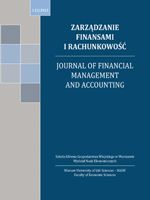Main Article Content
Article Details
AIT-SAHALIA Y., LO A.W. 2000: Nonparametric risk management and implied risk aversion, Journal of Econometrics 94, s. 9-51. (Crossref)
ANANCHOTIKUL N., ZHANG L. 2014: Portfolio Flows, Global Risk Aversion and Asset Prices in Emerging Markets, International Monetary Fund Working Paper 14/156. (Crossref)
ARROW K.J. 1970: The Theory of Risk Aversion (w:) K.J. Arrow (red.), Essays in the Theory of Risk Bearing, Markham, Chicago, s. 90-109.
BARTUNEK K., CHOWDHURY M. 1997: Implied risk aversion parameter from option prices, Financial Review 32, 1, s. 197-124. (Crossref)
BLISS R., PANIGIRTZOGLOU N. 2002: Testing the Stability of Implied Probability Density Functions, Journal of Banking & Finance 26, 2-3, 381-422. (Crossref)
BLISS R., PANIGIRTZOGLOU N. 2004: Option-Implied Risk Aversion Estimates, The Journal of Finance 59, 1, s. 407-446. (Crossref)
BOLLERSLEV T., GIBSON M., ZHOU H. 2011: Dynamic Estimation of Volatility Risk Premia and Investor Risk Aversion from Option-Implied and Realized Volatilities, Journal of Econometrics 160, 1, s. 235-245. (Crossref)
BREEDEN D., LITZENBERGER R. 1978: Prices of State-Contingent Claims Implicit in Option Prices, Journal of Business, 51, 4, s. 621-651. (Crossref)
BRUNNERMEIER M., NAGEL S., PEDERSEN L. 2008: Carry Traders and Currency Crashes, National Bureau of Economic Research Macroeconomics Annual 23, s. 313-347. (Crossref)
CLARIDA R., DAVIS J., PEDERSEN N. 2009: Currency carry trade regimes: Beyond the Fama regression, Journal of International Money and Finance 28, s. 1375-1389. (Crossref)
COUDERT V., GEX M. 2008: Does risk aversion drive financial crises? Testing the predictive power of empirical indicators, Journal of Empirical Finance 15, s. 167-184. (Crossref)
CZECH K. 2012: Walutowa strategia spekulacyjna "carry trade", Zeszyty Naukowe SGGW w Warszawie, Ekonomika i Organizacja Gospodarki Żywnościowej 95, 135-143. (Crossref)
DEMETERFI K., DERMAN E., KAMAL M., ZOU J. 1999: More than you ever wanted to know about volatility swaps, Quantitative Strategies Research Notes, Goldman Sachs.
DUPIRE B. 1994: Pricing with a Smile, Risk 7, 1, s. 18-20.
GAGNON J.E., CHABOUD A.P. 2007: What Can the Data Tell Us about Carry Trades in Japanese Yen?, International Finance Discussion Papers, 899, s. 1-29. (Crossref)
GARCIA-HERRERO A., ORTIZ A., COVAN K. 2006: The Role of Global Risk Aversion, in Explaining Sovereign Spreads, Economia 7, s. 125-155. (Crossref)
GERMANIER B. 2003: Updated risk index. Foreign exchange note, Union des Banques Suisses, September.
GIORDANO R., PERICOLI M., TOMMASINO P. 2013: Pure or Wake-up-Call Contagion? Another Look at the EMU Sovereign Debt Crisis, International Finance 16, s. 131-160. (Crossref)
GRANGER C.W.J. 1969: Investigating causal relations by econometric models and crossspectral methods, Econometrica 37, 3, s. 424-438. (Crossref)
HESTON S. 1993: A closed-form solution for options on assets with stochastic volatility with application to bond and currency options, Review of Financial Studies 6, 2, s. 327-343. (Crossref)
HULL J., WHITE A. 1987: The Pricing of Options on Assets with Stochastic Volatilities, The Journal of Finance 42, 2, s. 281-300. (Crossref)
JACKWERTH J. 2000: Recovering Risk Aversion from Option Prices and Realized Returns, Review of Financial Studies 13, 2, s. 433-451. (Crossref)
JACKWERTH J. 2004: Option-Implied Risk Neutral Distributions and Risk Aversion, Research Foundation of Association for Investment Management and Research, USA.
KANG B.J., KIM T.S. 2006: Option-implied risk preferences: An extension to wider classes of utility functions, Journal of Financial Markets 9, 2, s. 180-198. (Crossref)
KANTOR L., CAGLAYAN M. 2002: Using equities to trade FX: introducing the LCVI, J.P. Morgan Chase Bank, Global Foreign Exchange Research, Investment Strategies 7.
KUMAR M.S., PERSAUD A. 2002: Pure contagion and investors' shifting risk appetite: analytical issues and empirical evidence, International Finance 5, 3, s. 401-436. (Crossref)
LITNER J. 1965: The valuation of risk assets and the selection of risky investment in stock portfolios and capital budgets, Review of Economics and Statistics 47, 1, s. 13-37. (Crossref)
LIU M.-H., MARGARITIS D., TOURANI-RAD A. 2012: Risk appetite, carry trade and exchange rates, Global Finance Journal 23, s. 48-63. (Crossref)
OSIŃSKA M. 2008: Ekonometryczna analiza zależności przyczynowych, Wydawnictwo Naukowe Uniwersytetu Mikołaja Kopernika, Toruń.
PRATT J.W. 1964: Risk Aversion in the Small and in the Large, Econometrica 32, 1/2, s. 122-136. (Crossref)
ROSENBERG D. 2003: Introducing Merrill Lynch's proprietary weekly indicators, Merrill Lynch, The Market Economist, June, s. 4-10.
RUBINSTEIN M. 1994: Implied Binomial Trees, Journal of Finance 69, 3, s. 771-818. (Crossref)
SHARPE W. 1964: Capital asset prices: a theory of market equilibrium under condition of risk, Journal of Finance 19, 3, s. 425-442. (Crossref)
SHIMKO D. 1993: Bounds on Probability, Risk 6, s. 33-37.
ŚLEPACZUK R., ZAKRZEWSKI G. 2007: VIW20 - koncepcja indeksu zmienności dla polskiego rynku akcyjnego, E-finanse 4, s. 1-27.
VISTESEN C. 2009: Carry Trade Fundamentals and the Financial Crisis 2007-2010, Global Economy Matters, MPRA Paper 15265, s. 1-27.
WHALEY R.E. 1993: Derivatives on market volatility: hedging tools long overdue, The Journal of Derivatives 1, 1, s. 71-84. (Crossref)
WILMOT J., MIELCZARSKI P., SWEENEY J. 2004: Global Risk Appetite Index, Credit Suisse First Boston, Global Strategy Research: Market Focus, February.




